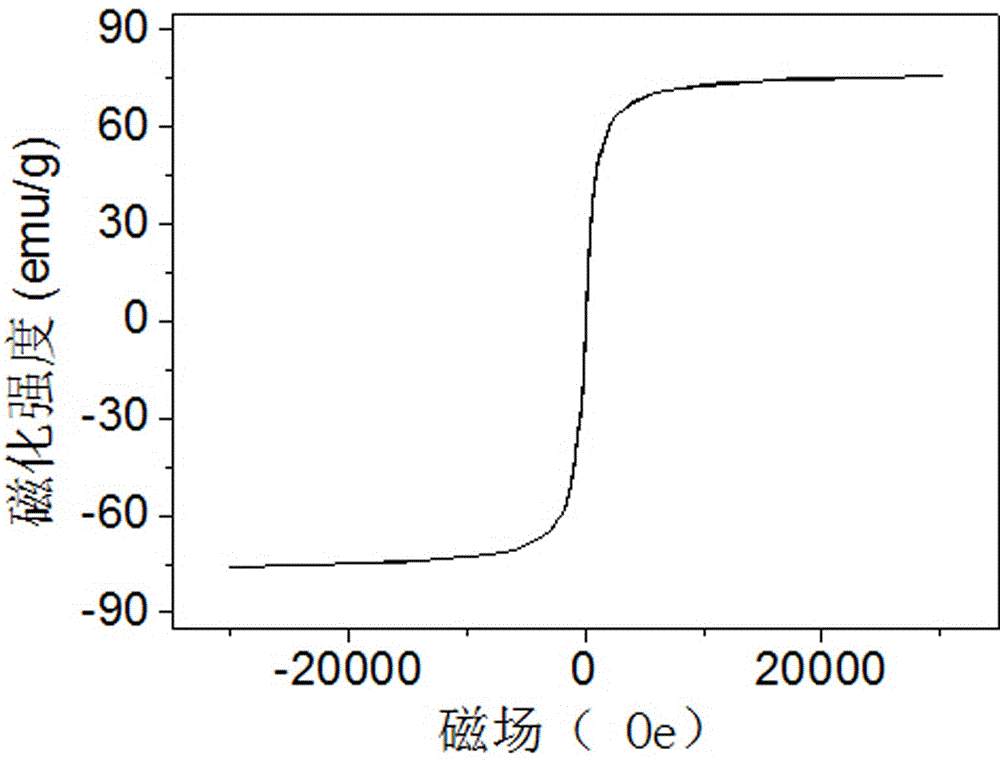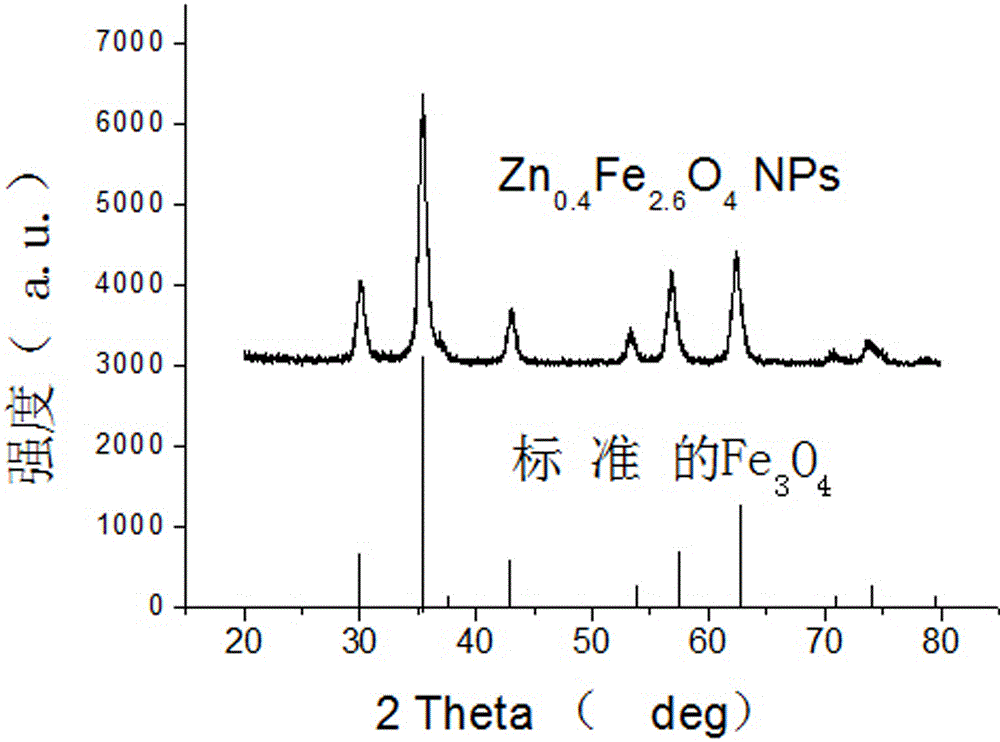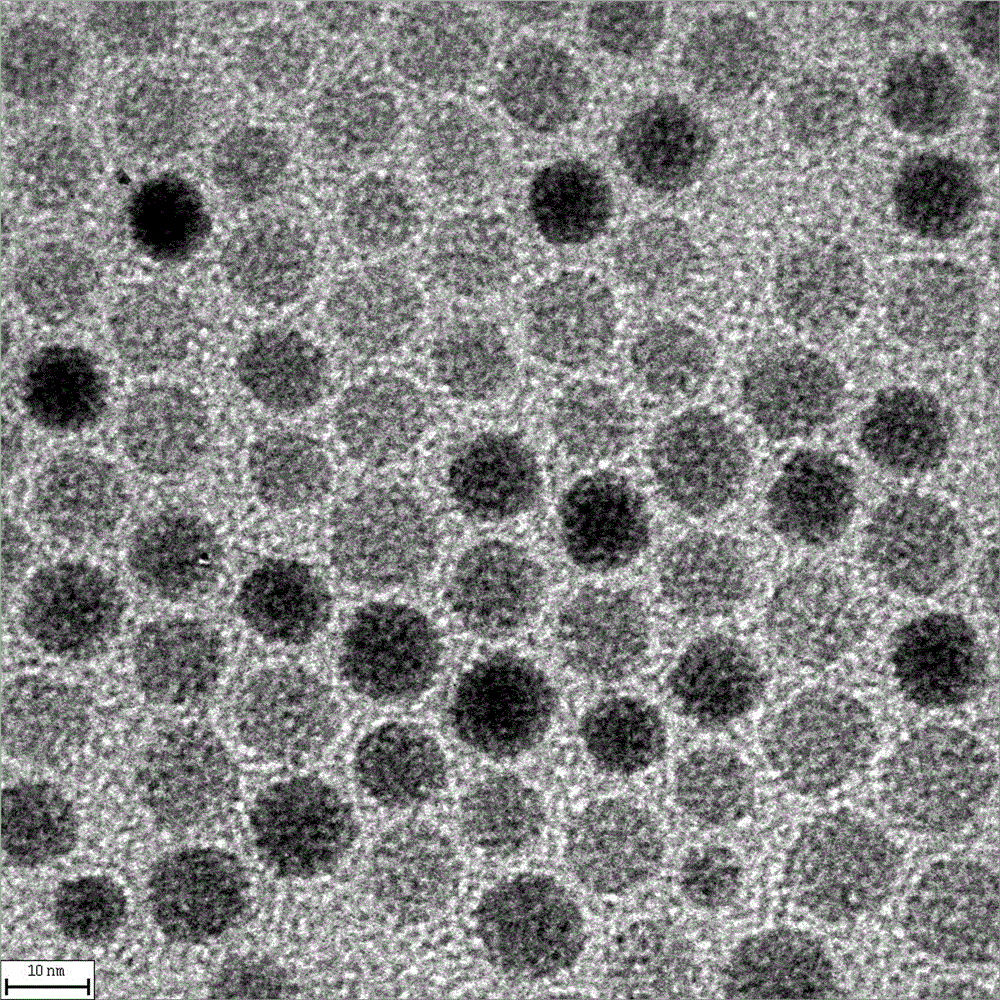A preparation method for hydrothermal synthesis of zinc-doped superparamagnetic ferric oxide nanoparticles
A technology of triiron tetroxide and nanoparticles, applied in the field of nano biomedical materials, can solve the problems of low magnetic saturation value and low crystallinity of products, achieve high crystallinity, simple preparation method and process, and meet the requirements of production and application. Effect
- Summary
- Abstract
- Description
- Claims
- Application Information
AI Technical Summary
Problems solved by technology
Method used
Image
Examples
Embodiment 1
[0025] First put FeSO 4 ·(NH 4 ) 2 SO 4 ·6H 2 O and ZnSO 4 Dissolve in 20ml of water to make the precursor reach 1.73×10 -3 mol Fe 2+ and 2.67×10 -4 mol Zn 2+ the goal of. Next, mix 10 ml of oleic acid, 10 ml of water and 1 g of NaOH, and magnetically stir at room temperature until a uniform solution is obtained. Furthermore, the precursor Fe 2+ And Zn 2+ Pour into the homogeneous solution and stir for a few minutes, the mixed solution turns dark brown. Finally, the solution was transferred into a 50ml reactor, sealed, and heated at 230 degrees for 15 hours. After the reaction, it was cooled to room temperature. The product is deposited on the bottom of the kettle, and the nanoparticles are taken out by dissolving with cyclohexane. Then ethanol was added to the cyclohexane containing the nanoparticles to precipitate the nanoparticles, and finally the nanoparticles were washed several times with ethanol. The organic surfactant on the surface of the particles is double exch...
Embodiment 2
[0027] First put FeSO 4 ·(NH 4 ) 2 SO 4 ·6H 2 O and ZnSO 4 Dissolve in 20ml of water to make the precursor reach 1.87×10 -3 mol Fe 2+ and 1.33×10 -4 mol Zn 2+ the goal of. Next, mix 10 ml of oleic acid, 10 ml of water and 1 g of NaOH, and magnetically stir at room temperature until a uniform solution is obtained. Furthermore, the precursor Fe 2+ And Zn 2+ Pour into the homogeneous solution and stir for a few minutes, the mixed solution turns dark brown. Finally, the solution was transferred into a 50ml reactor, sealed, and heated at 230 degrees for 15 hours. After the reaction, it was cooled to room temperature. The product is deposited on the bottom of the kettle, and the nanoparticles are taken out by dissolving with cyclohexane. Then ethanol was added to the cyclohexane containing the nanoparticles to precipitate the nanoparticles, and finally the nanoparticles were washed several times with ethanol. The organic surfactant on the surface of the particles is double exch...
Embodiment 3
[0029] First put FeSO 4 ·(NH 4 ) 2 SO 4 ·6H 2 O and ZnSO 4 Dissolve in 20ml of water to make the precursor reach 1.67×10 -3 mol Fe 2+ and 3.33×10 -4 mol Zn 2+ the goal of. Next, mix 10 ml of oleic acid, 10 ml of water and 1 g of NaOH, and magnetically stir at room temperature until a uniform solution is obtained. Furthermore, the precursor Fe 2+ And Zn 2+ Pour into the homogeneous solution and stir for a few minutes, the mixed solution turns dark brown. Finally, the solution was transferred into a 50ml reactor, sealed, and heated at 230 degrees for 15 hours. After the reaction, it was cooled to room temperature. The product is deposited on the bottom of the kettle, and the nanoparticles are taken out by dissolving with cyclohexane. Then ethanol was added to the cyclohexane containing the nanoparticles to precipitate the nanoparticles, and finally the nanoparticles were washed several times with ethanol. The organic surfactant on the surface of the particles is double exch...
PUM
 Login to View More
Login to View More Abstract
Description
Claims
Application Information
 Login to View More
Login to View More - R&D
- Intellectual Property
- Life Sciences
- Materials
- Tech Scout
- Unparalleled Data Quality
- Higher Quality Content
- 60% Fewer Hallucinations
Browse by: Latest US Patents, China's latest patents, Technical Efficacy Thesaurus, Application Domain, Technology Topic, Popular Technical Reports.
© 2025 PatSnap. All rights reserved.Legal|Privacy policy|Modern Slavery Act Transparency Statement|Sitemap|About US| Contact US: help@patsnap.com



